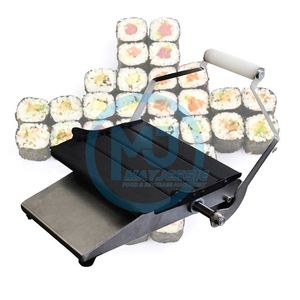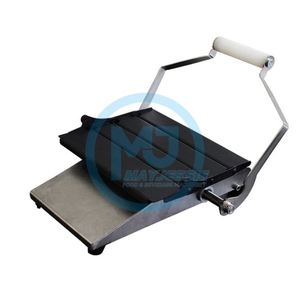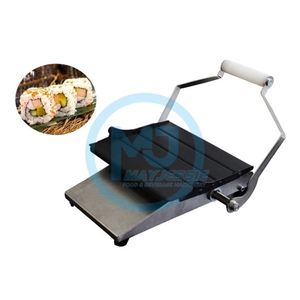(1887 products available)

















































































































































































Sushi is one of the most famous Japanese cuisines around the world. Being a traditional dish, people still prefer the authentic taste and the traditional style of making it. Nonetheless, with the passage of time, there is always a need for innovation and incorporation of technology in traditional practices to make them suitable for the present era. One such innovation is the introduction of sushi makimono machines. These machines, often called sushi rolling machines, are designed to simplify the process of making sushi rolls while maintaining the quality and taste of handmade sushi. Depending on the scale and demand, there are many types of sushi maki machines available. The commercial ones are used in restaurants, while the small and compact ones are used at home. Even though the machine can roll sushi, nothing can beat the authentic taste made manually by hand. However, this machine is an excellent option for those who are just starting with the cuisine and want to save time while making it.
Sushi maki machines are devices designed to help roll and shape sushi, especially maki (rolled sushi). From simple manual devices to complex automated machines, there is a wide range of sushi maki machines. Each type has its unique features and advantages. The main types of sushi maki machines include:
There are several types of sushi maki machines available, each designed to cater to a different need or preference. Whether one wants a traditional hand-rolled machine or a modern electric model, there is a machine that can help make sushi-making easier and more enjoyable.
Sushi maki machines have different designs, each with features and benefits that suit various needs and tastes. The following is a glimpse into the various styles of sushi rolling machines.
Roller design
Roller machines use rollers to compress and roll the sushi. The rollers can be manual or electric. The rollers are often adjustable to allow for the desired tightness of the sushi roll.
Sheet press design
Sushi machines with a sheet press design use a press to compact the ingredients into a sheet. The machine then rolls the sheet into a cylindrical shape. These machines are good for making large amounts of sushi at once.
Wrap-and-roll design
Some machines are shaped like a mat. The sushi maker puts the ingredients on top of the mat and rolls them up. These machines are usually compact and easy to use. They are also good for making sushi on the go.
Conveyor belt design
More advanced sushi machines come with a conveyor belt. The chef puts the rice and fillings on the moving belt, and they are rolled into maki in front of the sushi chef. These machines are perfect for busy restaurants with a high sushi demand.
Forming jig design
A forming jig holds the shape of the roll while it is being made. The jig keeps the ingredients in place as the sushi chef rolls them up. Jigs come in different sizes to make various-sized rolls.
Press mold design
Maki molds compact the sushi rice and fillings into a roll shape when pressed. Press molds are simple to use and produce consistent and uniform sushi rolls every time. They are great for beginners who are just learning how to make sushi.
Sushi machines are helpful in many settings. They help create sushi rolls quickly and consistently. These are some places where sushi makers are valuable.
Restaurants
Sushi restaurants and other eateries that offer sushi can use maki machines to roll the sushi for their customers. They can make a wide variety of rolls, such as nigiri sushi maker machine, with different flavors. The machines help the chefs work fast and keep the quality the same. They are especially helpful during busy times when many customers order at once.
Catering Services
Catering companies that serve sushi at events like weddings, parties, and corporate meetings can use sushi machines to prepare the rolls in large quantities. The machines help them make beautiful and fresh sushi that is easy to serve to many guests.
Supermarkets and Grocery Stores
Stores with sushi bars or ready-to-eat sections can use sushi machines to make sushi for customers. With the machine, sushi is made quickly and kept fresh for people to buy. This is popular because many people want healthy fast food.
Sushi Workshops and Cooking Classes
Places that teach people how to make sushi can use these machines as part of the lesson. Students can learn about traditional methods and see how machines can help with the rolling process. They can then try rolling by hand after watching the machine do it.
Food Trucks and Street Food Stalls
Food trucks or small mobile eateries that serve sushi on the go can benefit from having a maki machine inside. Space is often limited in these vehicles, so being able to roll sushi quickly and efficiently with a machine saves time when making each order for customers who want something tasty wrapped up fast.
Bars and Lounge
Establishments serving alcoholic drinks alongside food items may want to include some forms of exotic cuisine items into their menu lists; hence, having a few sets of sushi-making machines would come in handy here, too, since they are compact but very effective.
Research Institutions and Food Innovation Centers
Scientists studying food technology or companies working on developing new types of snacks could use sushi-making machines. These students can explore ways to change traditional Japanese cuisine concepts through automation techniques.
When choosing a sushi maki machine, there are several important factors to consider to ensure it meets the establishment's needs and can produce high-quality sushi efficiently. These factors include:
Q1: Does the sushi maki machine have a warranty period?
A1: Yes, most sushi maki machines have a warranty period during which any manufacturing defects will be repaired free of charge.
Q2: What kind of post-sale support can be expected for the sushi maki machine?
A2: Suppliers usually provide online technical support, troubleshooting guides, and spare parts assistance to ensure the machine operates smoothly.
Q3: How should the sushi maki machine be cleaned after use?
A3: The machine should be disassembled, and its parts should be washed using warm soapy water before being rinsed under clean water and dried thoroughly.
Q4: Can different sizes of sushi rolls be produced using the machine?
A4: Yes, some machines allow size adjustments, while others offer different-sized mats to make various-sized rolls.
Q5: What kind of power supply does the sushi maki machine require?
A5: These machines typically need a standard voltage power supply, but checking the specifications for any special requirements is essential.